 | ||
Engineers use reflection lines to judge a surface's quality. Reflection lines reveal surface flaws, particularly discontinuities in normals indicating that the surface is not
Contents
Mathematical Definition
Let us consider a point
For reflection lines we consider repeated infinite, non-dispersive light sources parallel to some line
and similarly let
Finally, define
Then the *reflection line function*
where
Finally, to render the reflection lines positive values
Highlight lines
Highlight lines are a view-independent alternative to reflection lines. Here the projected normal is directly compared against some arbitrary vector
where
The relationship between reflection lines and highlight lines is likened to that between specular and diffuse shading.
